Broadband Absorption Tailoring of SiO2/Cu/ITO Arrays Based on Hybrid Coupled Resonance Mode
Abstract
1. Introduction
2. Methods and Model Design
3. Results and Discussion
3.1. Modulation of Absorption in Different Periods
3.2. Modulation of Absorption by Layer Thickness
3.3. Verification of the Hybrid Coupled Resonance Mode
4. Conclusions
Supplementary Materials
Author Contributions
Funding
Conflicts of Interest
References
- Weiner, J. Light-matter interaction. Phys. Today 2013, 67, 53–54. [Google Scholar]
- Aoyagi, Y.; Kajikawa, K. Optical Properties of Advanced Materials; Springer: Berlin/Heidelberg, Germany, 2013; pp. 39–65. [Google Scholar]
- Ajayan, P.M. Nanocomposite Science and Technology; Wiley-VCH: Weinheim, Baden-Württemberg, Germany, 2003; pp. 215–222. [Google Scholar]
- Li, Z.Y.; Li, J.F. Recent progress in engineering and application of surface plasmon resonance in metal nanostructures. Chin. J. 2011, 56, 2631. [Google Scholar] [CrossRef]
- Brown, R.G.W. Absorption and Scattering of Light by Small Particles. Opt. Acta Int. J. Opt. 2010, 31, 1. [Google Scholar] [CrossRef]
- Maier, S.A. Plasmonics: Fundamentals and Applications; Springer: Berlin/Heidelberg, Germany, 2007; Volume 52, pp. 49–74. [Google Scholar]
- Miller, M.M.; Lazarides, A.A. Sensitivity of metal nanoparticle surface plasmon resonance to the dielectric environment. J. Phys. Chem. B 2005, 109, 21556–21565. [Google Scholar] [CrossRef] [PubMed]
- Barnes, W.L.; Dereux, A.; Ebbesen, T.W. Surface plasmon subwavelength optics. J. Beijing Technol. Bus. Univ. 2003, 424, 824–830. [Google Scholar] [CrossRef] [PubMed]
- Liu, Y.; Chu, Y.; Zhuo, Y.; Dong, L.; Li, L.; Li, M. Controlled synthesis of various hollow Cu nano/microStructures via a novel reduction route. Adv. Funct. Mater. 2007, 17, 933–938. [Google Scholar] [CrossRef]
- Hayes, J.R.; Nyce, G.W.; Kuntz, J.D.; Satcher, J.H.; Hamza, A.V. Synthesis of bi-modal nanoporous Cu, CuO and Cu2O monoliths with tailored porosity. Nanotechnology 2007, 18. [Google Scholar] [CrossRef]
- Sonnichsen, C.; Alivisatos, A.P. Gold nanorods as novel nonbleaching plasmon-based orientation sensors for polarized single-particle microscopy. Nano Lett. 2005, 5, 301–304. [Google Scholar] [CrossRef]
- Raschke, G.; Brogl, S.; Susha, A.S.; Rogach, A.L.; Klar, T.A.; Feldmann, J.; Fieres, B.; Petkov, N.; Bein, T.; Nichtl, A.; et al. Gold nanoshells improve single nanoparticle molecular sensors. Nano Lett. 2004, 4, 1853–1857. [Google Scholar] [CrossRef]
- McFarland, A.D.; Van Duyne, R.P. Single silver nanoparticles as real-time optical sensors with zeptomole sensitivity. Nano Lett. 2003, 3, 1057–1062. [Google Scholar] [CrossRef]
- Xu, H.X.; Kall, M. Surface-plasmon-enhanced optical forces in silver nanoaggregates. Phys. Rev. Lett. 2002, 89. [Google Scholar] [CrossRef] [PubMed]
- Rice, K.P.; Walker, E.J., Jr.; Stoykovich, M.P.; Saunders, A.E. Solvent-Dependent Surface Plasmon Response and Oxidation of Copper Nanocrystals. J. Phys. Chem. C 2011, 115, 1793–1799. [Google Scholar] [CrossRef]
- Yin, M.; Wu, C.K.; Lou, Y.B.; Burda, C.; Koberstein, J.T.; Zhu, Y.M.; O’Brien, S. Copper oxide nanocrystals. J. Am. Chem. Soc. 2005, 127, 9506–9511. [Google Scholar] [CrossRef] [PubMed]
- Peña-Rodríguez, O.; Pal, U. Effects of surface oxidation on the linear optical properties of Cu nanoparticles. J. Opt. Soc. Am. B 2011, 28, 2735–2739. [Google Scholar] [CrossRef][Green Version]
- Boltasseva, A.; Atwater, H.A. Materials science. Low-loss plasmonic metamaterials. Science 2011, 331, 290–291. [Google Scholar] [CrossRef]
- Zhang, J.; Zhang, L. Nanostructures for surface plasmons. Adv. Opt. Photonics 2012, 4, 157. [Google Scholar] [CrossRef]
- Wang, Y.; Overvig, A.C.; Shrestha, S.; Zhang, R.; Wang, R.; Yu, N.; Dal Negro, L. Tunability of indium tin oxide materials for mid-infrared plasmonics applications. Opt. Mater. Express 2017, 7, 2727. [Google Scholar] [CrossRef]
- Cleary, J.W.; Smith, E.M.; Leedy, K.D.; Grzybowski, G.; Guo, J. Optical and electrical properties of ultra-thin indium tin oxide nanofilms on silicon for infrared photonics. Opt. Mater. Express 2018, 8, 1231. [Google Scholar] [CrossRef]
- Naik, G.V.; Shalaev, V.M.; Boltasseva, A. Alternative plasmonic materials: Beyond gold and silver. Adv. Mater. 2013, 25, 3264–3294. [Google Scholar] [CrossRef]
- Hu, S.; Lu, K.; Ning, H.; Fang, Z.; Liu, X.; Xie, W.; Yao, R.; Zou, J.; Xu, M.; Peng, J. Effect of ITO Serving as a Barrier Layer for Cu Electrodes on Performance of a-IGZO TFT. IEEE Electron Device Lett. 2018, 39, 504–507. [Google Scholar] [CrossRef]
- Alam, M.Z.; De Leon, I.; Boyd, R.W. Large optical nonlinearity of indium tin oxide in its epsilon-near-zero region. Science 2016, 352, 795–797. [Google Scholar] [CrossRef] [PubMed]
- Tao, L.; Anopchenko, A.; Gurung, S.; Zhang, J.; Lee, H.W.H. Gate-Tunable Plasmon-Induced Transparency Modulator Based on Stub-Resonator Waveguide with Epsilon-Near-Zero Materials. Sci. Rep. 2019, 9, 2789. [Google Scholar] [CrossRef] [PubMed]
- Ji, W.; Wang, D.; Li, S.; Shang, Y.; Xiong, W.; Zhang, L.; Luo, J. Photonic-doped epsilon-near-zero media for coherent perfect absorption. Appl. Phys. A 2019, 125. [Google Scholar] [CrossRef]
- Huang, T.; Wu, Y.; Xie, Y.; Cheng, Z. A slot-waveguide-based polarization beam splitter assisted by epsilon-near-zero material. Photonics Nanostruct. Fundam. Appl. 2019, 33, 42–47. [Google Scholar] [CrossRef]
- Liu, X.; Zang, K.; Kang, J.-H.; Park, J.; Harris, J.S.; Kik, P.G.; Brongersma, M.L. Epsilon-Near-Zero Si Slot-Waveguide Modulator. ACS Photonics 2018, 5, 4484–4490. [Google Scholar] [CrossRef]
- Jiang, X.; Lu, H.; Li, Q.; Zhou, H.; Zhang, S.; Zhang, H. Epsilon-near-zero medium for optical switches in a monolithic waveguide chip at 1.9 μm. Nanophotonics 2018, 7, 1835–1843. [Google Scholar] [CrossRef]
- Amin, R.; Maiti, R.; Carfano, C.; Ma, Z.; Tahersima, M.H.; Lilach, Y.; Ratnayake, D.; Dalir, H.; Sorger, V.J. 0.52 V mm ITO-based Mach-Zehnder modulator in silicon photonics. APL Photonics 2018, 3, 126104. [Google Scholar] [CrossRef]
- Lian, J.; Zhang, D.; Hong, R.; Qiu, P.; Lv, T.; Zhang, D. Defect-Induced Tunable Permittivity of Epsilon-Near-Zero in Indium Tin Oxide Thin Films. Nanomaterials 2018, 8. [Google Scholar] [CrossRef]
- Urbas, A.M.; Jacob, Z.; Negro, L.D.; Engheta, N.; Boardman, A.D.; Egan, P.; Khanikaev, A.B.; Menon, V.; Ferrera, M.; Kinsey, N.; et al. Roadmap on optical metamaterials. J. Opt. 2016, 18, 093005. [Google Scholar] [CrossRef]
- Van Dijken, J.G.; Brett, M.J. Nanopillar ITO electrodes via argon plasma etching. J. Vac. Sci. Technol. A Vac. Surf. Film 2012, 30, 040606. [Google Scholar] [CrossRef]
- Li, S.Q.; Guo, P.; Zhang, L.; Zhou, W.; Odom, T.W.; Seideman, T.; Ketterson, J.B.; Chang, R.P. Infrared plasmonics with indium-tin-oxide nanorod arrays. ACS Nano 2011, 5, 9161. [Google Scholar] [CrossRef] [PubMed]
- Hendrickson, J.R.; Vangala, S.; Dass, C.; Gibson, R.; Goldsmith, J.; Leedy, K.; Walker, D.E.; Cleary, J.W.; Kim, W.; Guo, J. Coupling of Epsilon-Near-Zero Mode to Gap Plasmon Mode for Flat-Top Wideband Perfect Light Absorption. ACS Photonics 2018, 5, 776–781. [Google Scholar] [CrossRef]
- Li, S.-Q.; Sakoda, K.; Ketterson, J.B.; Chang, R.P.H. Broadband resonances in indium-tin-oxide nanorod arrays. Appl. Phys. Lett. 2015, 107, 031104. [Google Scholar] [CrossRef]
- Li, S.-Q.; Guo, P.; Buchholz, D.B.; Zhou, W.; Hua, Y.; Odom, T.W.; Ketterson, J.B.; Ocola, L.E.; Sakoda, K.; Chang, R.P.H. Plasmonic–Photonic Mode Coupling in Indium-Tin-Oxide Nanorod Arrays. ACS Photonics 2014, 1, 163–172. [Google Scholar] [CrossRef]
- Zhou, K.; Cheng, Q.; Song, J.; Lu, L.; Jia, Z.; Li, J. Broadband perfect infrared absorption by tuning epsilon-near-zero and epsilon-near-pole resonances of multilayer ITO nanowires. Appl. Opt. 2018, 57, 102–111. [Google Scholar] [CrossRef] [PubMed]
- D’apuzzo, F.; Esposito, M.; Cuscunà, M.; Cannavale, A.; Gambino, S.; Lio, G.E.; De Luca, A.; Gigli, G.; Lupi, S. Mid-Infrared Plasmonic Excitation in Indium Tin Oxide Microhole Arrays. ACS Photonics 2018. [Google Scholar] [CrossRef]
- Groot, C.H.D.; Abb, M.; Papasimakis, N.; Muskens, O.L.; Wang, Y. Surface-Enhanced Infrared Spectroscopy using ultra-compact indium tin oxide (ITO) sensor arrays. In Proceedings of Lasers & Electro-Optics; Optical Society of America: Washington, DC, USA, 2014. [Google Scholar]
- Yang, C.C.; Chen, H.L.; Wang, J.Y.; Chuang, W.H.; Kiang, Y.W. Characteristics of light emitter coupling with surface plasmons in air/metal/dielectric grating structures. J. Opt. Soc. Am. B 2009, 26, 923–929. [Google Scholar]
- Liu, Y.; Gu, S.; Luo, C.; Zhao, X. Ultra-thin broadband metamaterial absorber. Appl. Phys. A 2012, 108, 19–24. [Google Scholar] [CrossRef]
- Feng, S.; Halterman, K. Coherent perfect absorption in epsilon-near-zero metamaterials. Phys. Rev. B 2012, 86. [Google Scholar] [CrossRef]
- Hendrickson, J.R.; Vangala, S.; Dass, C.K.; Gibson, R.; Guo, J. Experimental Observation of Strong Coupling Between an Epsilon-Near-Zero Mode in a Deep Subwavelength Nanofilm and a Gap Plasmon Mode. arXiv 2018, arXiv:1801.03139. [Google Scholar]
- Kim, J.; Naik, G.V.; Emani, N.K.; Guler, U.; Boltasseva, A. Plasmonic Resonances in Nanostructured Transparent Conducting Oxide Films. IEEE J. Sel. Top. Quantum Electron. 2013, 19, 4601907. [Google Scholar]
- Mie, G. Beitrage Zur Optik Trüber Medien, Speziell Kolloidaler Metallosungen. Ann. Phys. 1908, 330, 377–445. [Google Scholar] [CrossRef]
- Lock, J.A.; Gouesbet, G. Generalized Lorenz-Mie theory and applications. J. Quant. Spectrosc. Radiat. Transf. 2009, 110, 800–807. [Google Scholar] [CrossRef]
- Mundy, W.C.; Roux, J.A.; Smith, A.M. Mie scattering by spheres in an absorbing medium. J. Opt. Soc. Am. 1974, 64, 1593–1597. [Google Scholar] [CrossRef]
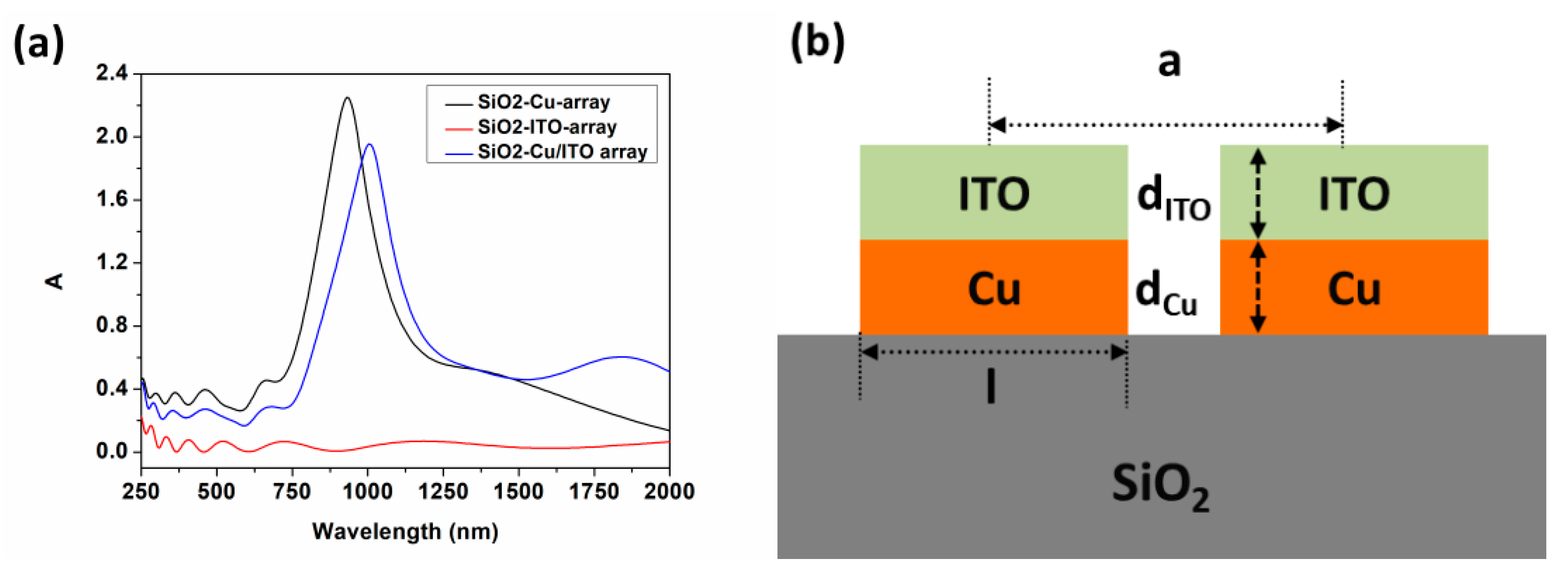
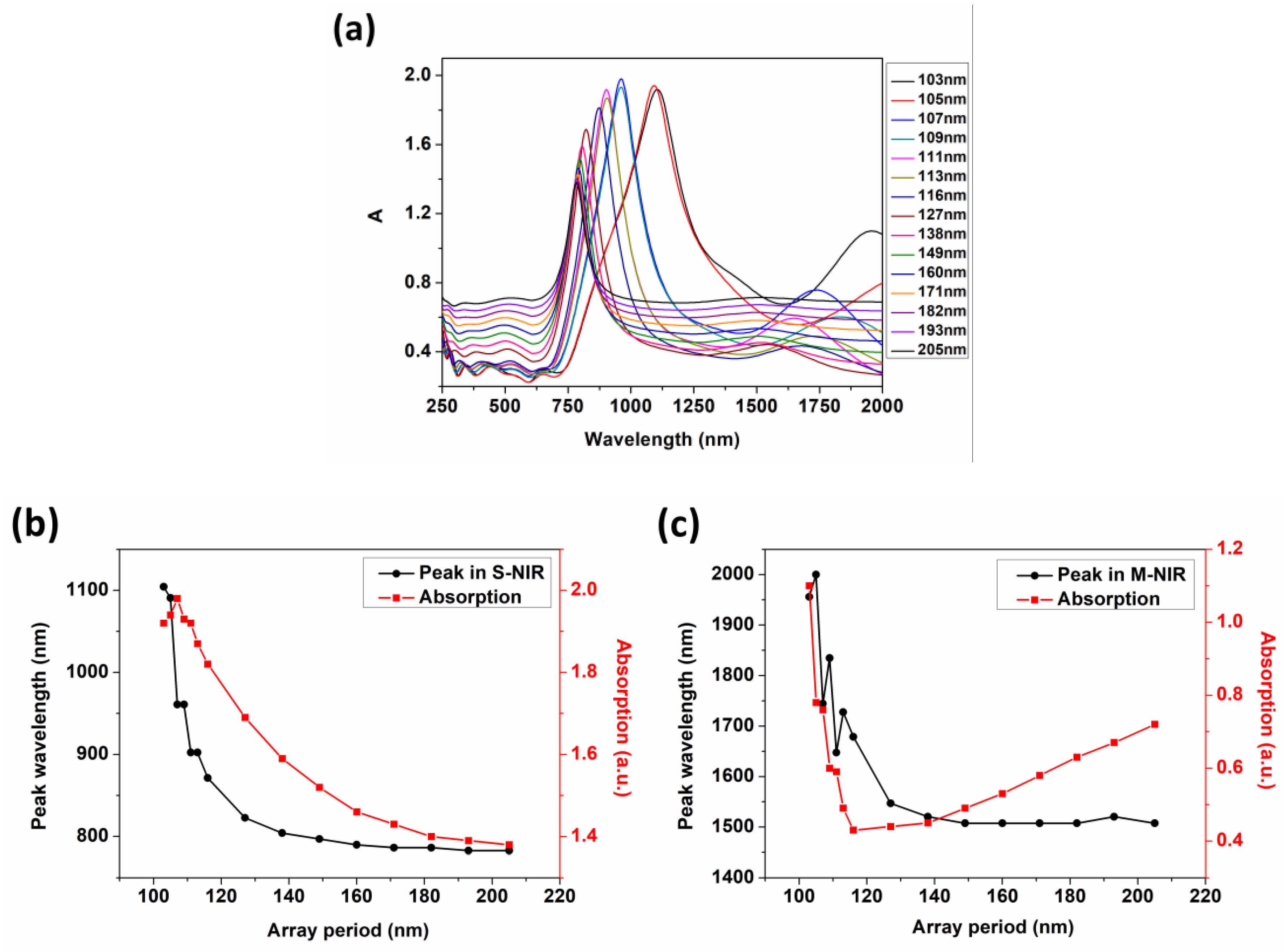
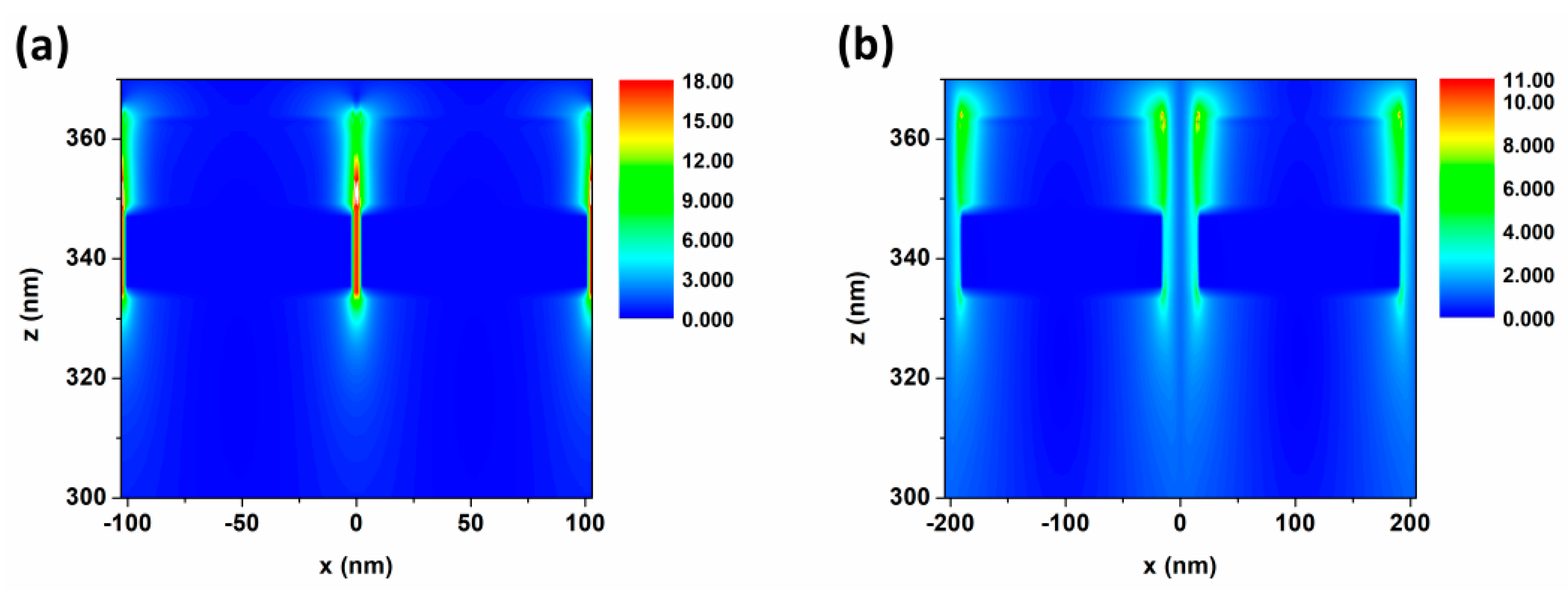
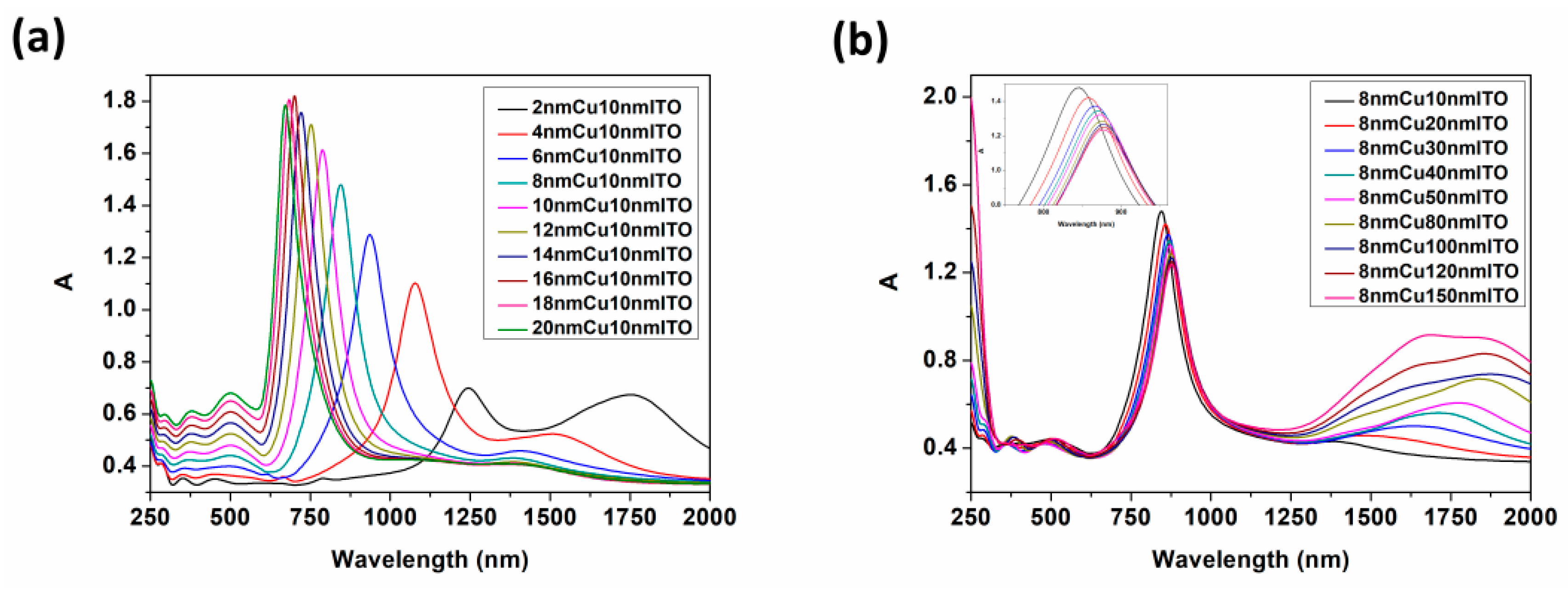

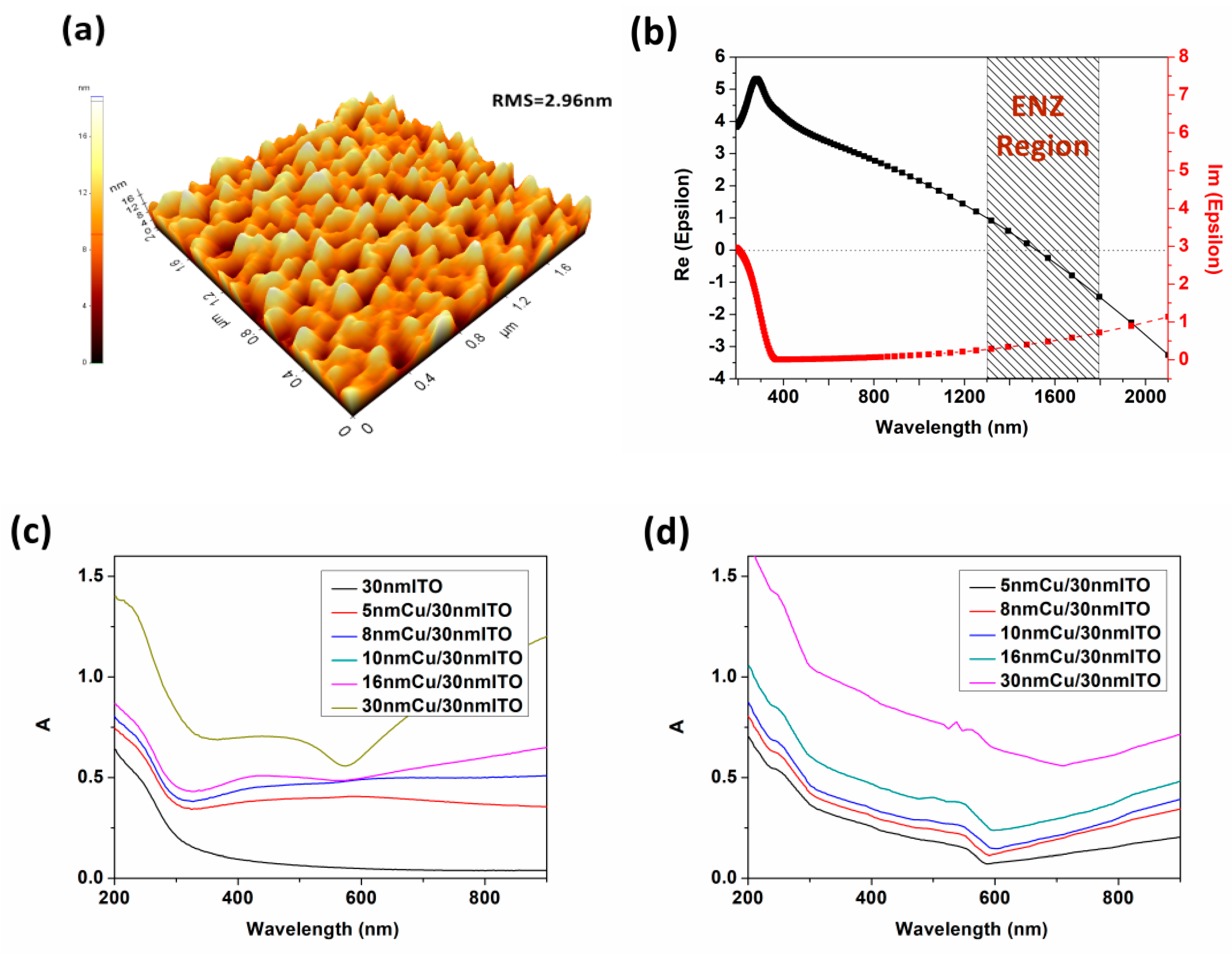
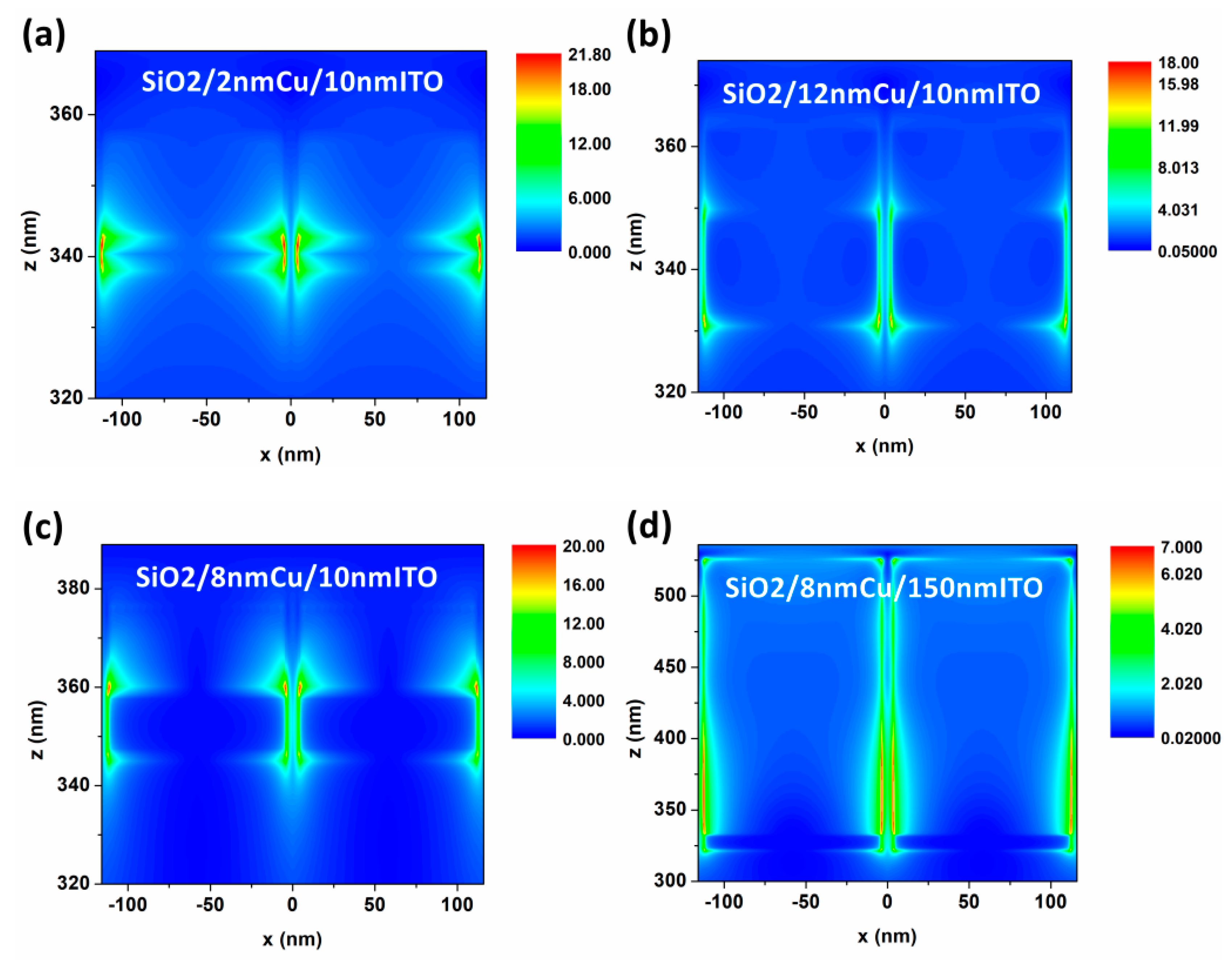

© 2019 by the authors. Licensee MDPI, Basel, Switzerland. This article is an open access article distributed under the terms and conditions of the Creative Commons Attribution (CC BY) license (http://creativecommons.org/licenses/by/4.0/).
Share and Cite
Lian, J.; Zhang, D.; Hong, R.; Yan, T.; Lv, T.; Zhang, D. Broadband Absorption Tailoring of SiO2/Cu/ITO Arrays Based on Hybrid Coupled Resonance Mode. Nanomaterials 2019, 9, 852. https://doi.org/10.3390/nano9060852
Lian J, Zhang D, Hong R, Yan T, Lv T, Zhang D. Broadband Absorption Tailoring of SiO2/Cu/ITO Arrays Based on Hybrid Coupled Resonance Mode. Nanomaterials. 2019; 9(6):852. https://doi.org/10.3390/nano9060852
Chicago/Turabian StyleLian, Jiqing, Dawei Zhang, Ruijin Hong, Tingzhen Yan, Taiguo Lv, and Daohua Zhang. 2019. "Broadband Absorption Tailoring of SiO2/Cu/ITO Arrays Based on Hybrid Coupled Resonance Mode" Nanomaterials 9, no. 6: 852. https://doi.org/10.3390/nano9060852
APA StyleLian, J., Zhang, D., Hong, R., Yan, T., Lv, T., & Zhang, D. (2019). Broadband Absorption Tailoring of SiO2/Cu/ITO Arrays Based on Hybrid Coupled Resonance Mode. Nanomaterials, 9(6), 852. https://doi.org/10.3390/nano9060852





